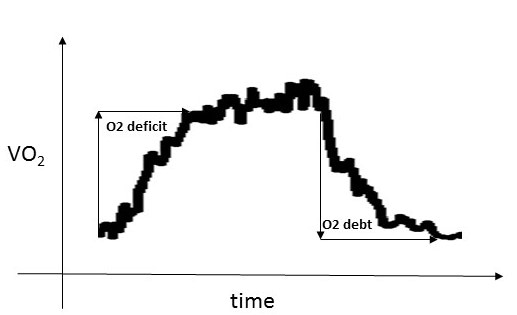There are three energy supply systems in our body. All three systems work on a smooth continuum.
- ATP – PCr (Immediate) energy system: An immediate energy supply required for a physical activity such as 100 m sprint or lifting a heavy weight (high intensity – short duration), comes mainly from intramuscular high-energy phosphates, ATPs and PCr. Such (very fast) energy supply lasts only less than 10 seconds and is also called as the alactic/anaerobic system.
- Lactic acid (short-term) energy system: When the physical activity of high intensity is continued, the lactic acid system kicks in and supplies ATP for up to 90 seconds. Such (fast) energy supply mainly comes from stored muscle glycogen through anaerobic glycolysis and hence also called as the lactic/anaerobic system.
- Aerobic (long-term) energy system: When the physical activity is continued further, aerobic metabolism takes over to supply energy to continue the work being done. The aerobic system is run by continued oxygen consumption (fuel supply), which rises exponentially along with the increase in the intensity of exercise. While performing physical activity on a constant work load, a steady state/rate of oxygen consumption is reached, reflecting a balance between energy demand from the muscles at work and the amount of ATP produced via aerobic metabolism. The energy supply for aerobic metabolism comes mainly from blood glucose, blood fats, muscle glycogen, muscle glycerides and ketones (breakdown from fats).
| ATP Supply (% contribution) | |||||
| Events | ATP-PCr | Anaerobic glycolysis | Aerobic glycolysis | Liver glycogen – blood glucose | Adipose tissue – Fatty acids – triglycerols |
| 100 m | 50 | 50 | – | – | – |
| 200 m | 25 | 65 | 10 | – | – |
| 800 m | 6 | 50 | 44 | – | – |
| marathon | – | – | 75 | 5 | 20 |
Oxygen deficit: At the start of a constant load physical activity, there will be a lag in oxygen consumption rate, even if the workload remains constant. The amount of oxygen that would have been consumed, had the oxygen consumption rate reached the steady state immediately right from the start of the constant load activity is called as oxygen deficit.
An individual trained aerobically reaches the steady state/rate of oxygen consumption faster than untrained individuals or power-trained athletes. Thus, an individual trained aerobically consumes more oxygen during a task that requires steady state/rate of oxygen consumption.
Oxygen debt / Recovery oxygen consumption: Oxygen debt is the difference between the total amount of oxygen consumed after exercise and the total amount of oxygen consumed at rest (theoretical/baseline resting VO2), during the recovery time period. This is also called as excess post-exercise oxygen consumption (EPOC).
Recovery from exercise involve resupply of oxygen (to the blood, tissues, fluids, muscle myoglobin), resynthesis of high energy phosphates, and also involve supplying energy to post-exercise accelerated tissue metabolism and increased circulation/ventilation.

References:
1. American College of Sports Medicine, 2013. ACSM’s guidelines for exercise testing and prescription. Lippincott Williams & Wilkins.
2. McArdle, W.D., Katch, F.I. and Katch, V.L., 2010. Exercise physiology: nutrition, energy, and human performance. Lippincott Williams & Wilkins.